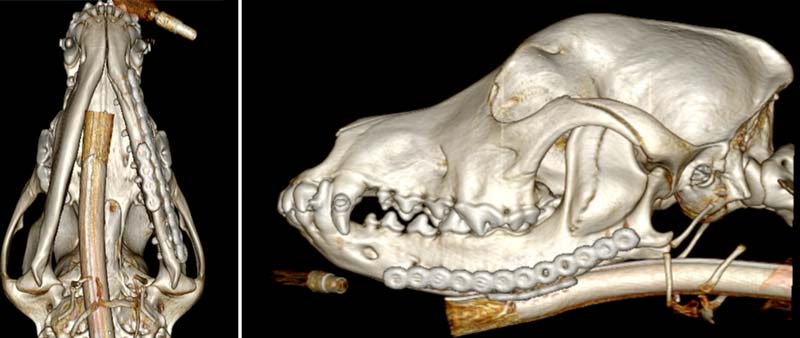5 Nov 2020
Surgeons at Eastcott Veterinary Referrals in Swindon carried out painstaking repairs on puppy after it suffered double fracture.

Lenny the cocker spaniel underwent specialist corrective surgery at Eastcott Veterinary Referrals.
Specialist dental and maxillofacial surgeons have performed major reconstruction surgery on a puppy that suffered a double fracture to the jaw after a kick from a horse.
Ten-month-old cocker spaniel Lenny underwent the surgery at Eastcott Veterinary Referrals in Swindon, repairing the fractures and other significant damage suffered while he was on a walk with his owners.
Andrew Perry – head of dentistry and oral and maxillofacial surgery at Eastcott, and a European and RCVS specialist in veterinary dentistry – said: “Lenny is a young working cocker spaniel who was sadly a little too inquisitive for his own good on this occasion. The puppy was out on a walk when he startled a horse and received a short shrift, in the form of a glancing blow to the jaw.
“Lenny was left in a distressed state and it was immediately clear that significant damage had been done. He was taken straight to his local vets, which gave him pain relief and stabilised him overnight before he was referred to us the next day.”
Mr Perry added: “Radiographs showed Lenny had sustained a significant fracture of his mandible, while a CT scan provided an exact appreciation of the dimensions of the fractures and their relationship to Lenny’s tooth roots. This is critical to preventing iatrogenic damage during any repair of mandibular fractures.
“The images clearly showed Lenny had two fractures – a rostral fracture and a caudal, lingually displaced fragment, with the displacement of the caudal fragment resulting in subluxation of the left temporomandibular joint.”

The injuries required complex surgery, including the insertion of titanium plates to stabilise and secure the jaw, to ensure Lenny did not suffer permanent damage.
Mr Perry said: “A transmylohyoid intubation was performed, allowing for Lenny’s mouth to be closed intraoperatively, and a temporary, elastic maxillomandibular fixation attached.
“Like all fractures, accurate anatomical reconstruction for fractures of the jaw is desirable, but it is imperative for a functional, stable occlusion to be the most basic goal of repair.”
Mr Perry added: “Lenny’s fractures were stabilised using titanium mini-plates, achieving rigid internal fixation. The caudal fragment was less stable, so orthogonal plates were used to maximise stress neutralisation and to aid in initial reduction.”

Lenny was eating within four hours of treatment, discharged from the Linnaeus practice 36 hours post-surgery and is making a full recovery.